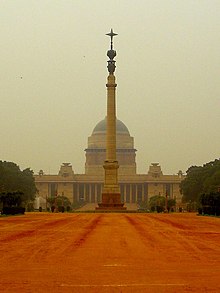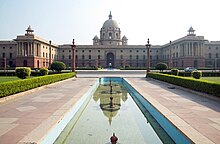Lutyens' Delhi
From Wikipedia, the free encyclopedia
Lutyens' Delhi is an area in New Delhi, Delhi, India, named after the leading British architect Edwin Lutyens (1869–1944), who was responsible for much of the architectural design and building when India was part of the British Empire in the 1920s and 1930s. This also includes the Lutyens Bungalow Zone (LBZ).
Contents
[hide]History[edit]
Before the new imperial capital New Delhi was established in 1911, the Old Delhi Railway Station served the Agra-Delhi railways, the line cut through what is today called Lutyens' Delhi. The line was eventually shifted to make way for the new capital and the New Delhi Railway Station was built near Ajmeri Gate in 1926.[1]
Design and construction[edit]
Lutyens led a team of architects in laying out the central administrative area of the city, with the charge of retaining one-third of the area as green space.[1] At the heart of the city was the impressive Rashtrapati Bhawan, formerly known as Viceroy's House, located on the top of Raisina Hill. The Rajpath, also known as King's Way, connects India Gate to Rashtrapati Bhawan, while Janpath, which crosses it at a right angle, connects South End Road (renamed as Rajesh Pilot Marg) withConnaught Place. Currently, Pranab Mukherjee is the President of India, and stays in the official house of Rashtrapati Bhawan.
The Secretariat Building, which house various ministries of the Government of India including the Prime Minister's Office, is beside the Rashtrapati Bhawan and was designed by Herbert Baker. Also designed by Baker was the Parliament House, located on the Sansad Marg, running parallel with the Rajpath. Two magnificent cathedrals in the area, the AnglicanCathedral Church of the Redemption and Catholic Sacred Heart Cathedral were designed by Henry Medd.[2][3]
Lutyens Bungalow Zone[edit]
"Lutyens Bungalow Zone" covers an area of about 26 km2. All land and buildings in the LBZ belong to the central government, except for 254.5 acres which is in private hands. There are about 1000 bungalows in the LBZ, of which less than ten percent are in private hands.[4]
In order to create development control norms, the Ministry of Urban Development constituted the 'New Delhi Redevelopment Advisory Committee' (NDRAC) in 1972, when the redevelopment of the areas around the walled city, north of Connaught Place and on Prithviraj Road was taken up.[5]
Land Prices in LBZ[edit]
The LBZ has the most expensive real estate in India, possibly the world. The market value of 254.5 acres of Land in private hands in the LBZ has increased eightfold in the last ten years, from around Rs6,100 crores to Rs 49,000 crores. In 2013, Rajan Mittal, Bharti Enterprises Vice-Chairman bought a bungalow in the zone for Rs 156 crore. In June 2014, Rajiv Rattan, India bulls co-founder, was reported, to have bought a 2,920 sq yard plot, for Rs 220 crore.[4][6]
Contiguous Areas[edit]
Around the great green expanse of the LBZ, is a thick swathe of green, a glacis of trees, and manicured lawns, and grand buildings, that protect and cushion LBZ from the swirl and swarm of Delhi’s crowded parts: on the west is the vast wooded area of the Delhi Ridge, adjoining the grand acres of the Presidential Estate; to the west and south is Nehru Park, the Race Course, the Air force station, the Delhi Gymkhana Club, Safdarjung Airport, Safdarjang Tomb, and pretentious modern sprawl of the Diplomatic enclave; to the south is the Lodi Gardens, with its fabulous Lodhi era tombs, and remains; on the SE are great lavishly tended greens ofDelhi Golf Club, with its Mughal era ruins; and beyond the Golf course, on the edge of the LBZ boundary is the green stretch of National Zoological Park, lakes, thePurana Qila, and the Humayun's Tomb. The contiguous areas are lavished with as much care by the government as the LBZ. Those who can’tBUY into the LBZ buy into the contiguous areas, like Jhor Bagh, where property prices are almost as steep as in the LBZ.[5]
into the LBZ buy into the contiguous areas, like Jhor Bagh, where property prices are almost as steep as in the LBZ.[5]
 into the LBZ buy into the contiguous areas, like Jhor Bagh, where property prices are almost as steep as in the LBZ.[5]
into the LBZ buy into the contiguous areas, like Jhor Bagh, where property prices are almost as steep as in the LBZ.[5]Prominent Political Residents[edit]
The official residence of Prime Minister of India, is in LBZ. He resides at 7, Race Course Road a complex of five bungalows, spread over 12 acres. The former Prime Minister Manmohan Singh, also resides in the LBZ.[7] He was allotted Type VIII bungalow, on 3 Motilal Nehru Marg, previously occupied by Delhi chief minister Sheila Dikshit, on 27 February 2014 by Kamal Nath Minister of Urban Development. Manmohan Singh, was allotted the sprawling bungalow on account of his being Rajya Sabha MP from Assam. Former Prime Ministers, not a member of Parliament (MP), are not entitled government bungalow. However, Mr. Atal Bihari Vajpayee, not a Member of any house continues to reside in a sprawling bungalow on Krishna Menon Marg since 2005.[8]
Prominent Business men in LBZ[edit]
Laxmi N Mittal, KP Singh, Sunil Mittal, CK Birla, the Burmans, Shashi and Ravi Ruia, Malvinder and Shivinder Singh, Analjit Singh, Atul Punj, and Hari Bhartia amongst others.[6]
Overview[edit]
Despite its name, Edwin Lutyens, the architect of Delhi, designed 4 bungalows in the Rashtrapati Bhavan Estate, (Viceroy House Estate); now, these bungalows lie on the Mother Teresa Crescent (then Willingdon Crescent). Lutyens, apart from designing the Viceroy's House, designed large government building and was involved with town planning.[1]
Herbert Baker, who also designed with the Secretariat Buildings (North and South Block), designed bungalows on the then King George's Avenue (south of the Secretariats) for high-ranking officials. Other members of the team of architects were Robert Tor Russell, who built Connaught Place, the Eastern and Western Courts on Janpath, Teen Murti House, Safdarjung Airport, National Stadium and several government houses,[9] William Henry Nicholls, CG Blomfield, FB Blomfield,Walter Sykes George, Arthur Gordon Shoosmith and Henry Medd.[1][10]
It is on the 2002 World Monuments Watch list of 100 Most Endangered Sites made by World Monuments Fund, a heritage organization based in New York.[11]






No comments:
Post a Comment